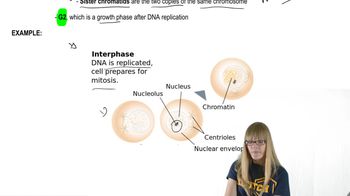Table of contents
- 1. Introduction to Genetics51m
- 2. Mendel's Laws of Inheritance3h 37m
- 3. Extensions to Mendelian Inheritance2h 41m
- 4. Genetic Mapping and Linkage2h 28m
- 5. Genetics of Bacteria and Viruses1h 21m
- 6. Chromosomal Variation1h 48m
- 7. DNA and Chromosome Structure56m
- 8. DNA Replication1h 10m
- 9. Mitosis and Meiosis1h 34m
- 10. Transcription1h 0m
- 11. Translation58m
- 12. Gene Regulation in Prokaryotes1h 19m
- 13. Gene Regulation in Eukaryotes44m
- 14. Genetic Control of Development44m
- 15. Genomes and Genomics1h 50m
- 16. Transposable Elements47m
- 17. Mutation, Repair, and Recombination1h 6m
- 18. Molecular Genetic Tools19m
- 19. Cancer Genetics29m
- 20. Quantitative Genetics1h 26m
- 21. Population Genetics50m
- 22. Evolutionary Genetics29m
9. Mitosis and Meiosis
Mitosis
Problem 31a
Textbook Question
The cell cycle operates in the same way in all eukaryotes, from single-celled yeast to humans, and all share numerous genes whose functions are essential for the normal progression of the cycle. Discuss why you think this is the case.
 Verified step by step guidance
Verified step by step guidance1
<span>The cell cycle is a fundamental process that is crucial for the growth and reproduction of eukaryotic cells. It involves a series of stages that lead to cell division and replication. This process is highly conserved across eukaryotes, from yeast to humans, due to its essential role in maintaining life.</span>
<span>One reason for the conservation of the cell cycle is that it ensures the accurate replication and distribution of the cell's genetic material. This is vital for the survival and function of all eukaryotic organisms, as errors in this process can lead to cell death or diseases such as cancer.</span>
<span>Another reason is the evolutionary advantage of having a highly efficient and reliable mechanism for cell division. Natural selection favors organisms that can reproduce effectively, and a conserved cell cycle provides a stable framework for this process.</span>
<span>The conservation of cell cycle genes across eukaryotes also suggests that these genes perform fundamental roles that are necessary for cellular function. These genes have been preserved through evolutionary time because they are critical for the basic operations of the cell.</span>
<span>Finally, the study of model organisms like yeast has provided significant insights into the cell cycle, as the fundamental mechanisms are similar across species. This allows researchers to apply findings from simple organisms to more complex ones, including humans.</span>
Recommended similar problem, with video answer:
 Verified Solution
Verified SolutionThis video solution was recommended by our tutors as helpful for the problem above
Video duration:
2mPlay a video:
Was this helpful?
Key Concepts
Here are the essential concepts you must grasp in order to answer the question correctly.
Cell Cycle
The cell cycle is a series of phases that a cell goes through to grow and divide. It consists of interphase (G1, S, G2) and the mitotic phase (M), where the cell prepares for division and ultimately splits into two daughter cells. This process is crucial for growth, development, and tissue repair in eukaryotic organisms.
Recommended video:
Guided course

Bacteriophage Life Cycle
Conservation of Genetic Mechanisms
Many fundamental biological processes, including the cell cycle, are highly conserved across eukaryotic species due to evolutionary pressures. This means that the genes and proteins involved in these processes have remained relatively unchanged over time, reflecting their essential roles in cellular function and organismal development.
Recommended video:
Guided course

History of Genetics
Eukaryotic Cell Structure
Eukaryotic cells are characterized by their complex structure, including a defined nucleus and various organelles. This complexity necessitates a regulated cell cycle to ensure proper DNA replication and distribution during cell division, which is vital for maintaining genetic stability and function across diverse eukaryotic life forms.
Recommended video:
Guided course

Chromosome Structure
Related Videos
Related Practice





